 Advances in Pure Mathematics, 2011, 1, 16-22 doi:10.4236/apm.2011.12005 Published Online March 2011 (http://www.SciRP.org/journal/apm) Copyright © 2011 SciRes. APM The Pell Equation 222 = D k Amara Chandoul Institut supérieur d’Informa tique et de Multimedia de Sfax, Sfax, Tunisia E-mail: amarachandoul@yaho o.fr Received January 9, 2011; revised January 29, 2011; accepted February 5, 2011 Abstract Let 1 be a positive non-square integer and 2k be any fixed integer. Extending the work of A. Tek- can, here we obtain some formulas for the integer solutions of the Pell equation 222 = Dy k. Keywords: Pell’s Equation, Solutions of Pell’s Equation 1. Introduction The equation 22 = Dy N, with given integers D and N and unknowns and y, is called Pell’s equation. If D is negative, it can have only a finite number of solutions. If D is a perfect square, say 2 =Da, the equation reduces to = ayx ayN and again there is only a finite number of solutions. The most interesting case of the equation arises when 1D be a positive non-square. Although J. Pell contributed very little to the analysis of the equation, it bears his name because of a mistake by Euler. Pell’s equation 22 =1xDy was solved by Lagrange in terms of simple continued fractions. Lagrange was the first to prove that 22 =1xDy has infinitly many solu- tions in integers if 1D is a fixed positive non-square integer. If the lenght of the periode of D is 1, all po- sitive solutions are given by 21 =vk xP and 21 =vk yQ if k is odd, and by 1 =vk P and 1 =vk yQ if k is even, where =1,2,v and n n P Q denotes the nth con- vergent of the continued fraction expansion of D Inci- dentally, 21 1 =vk xP and 21 1 =, vk yQ =1,2,v, are the positive solutions of 22 =1xDy provided that 1 is odd. There is no solution of 22 =1xDy other than ,:=1,2, vv xyv given by 11 = v vv Dyx Dy, where 11 , y is the least positive solution called the fundamental solution, which there are different method for finding it. The reader can find many references in the subject in the book [7]. For completeness we recall that there are many papers in which are considered different types of Pell's equation. Many authors such as Tekcan [1], Kaplan and Williams [2], Matthews [3], Mollin, Poorten and Williams [4], Stevenhagen [5] and the others consider eome specific Pell equations and their integer solutions. A. Tekcan in [1], considered the equation 22 =4xDy, and he ob- tained some formulas for its integer solutions. He mentioned two conjecture which was proved by A. S. Shabani [6]. In this paper we extend the work of A. Tek- can by considering the Pell equation 222 = Dy k when 1D be a positive non-square and 2k, we obtain some formulas for its integer solutions. 2. The Pell Equation 222 = Dy k In this section, we consider the solutions of Pell's equation 222 = Dy k when 2k. Theorem 2.1 Let 11 , y be the fundamental solu- tion of the Pell equation 222 = Dy k, and let 11 11 1 0 n n n uxDy vyx (1) for 1n. Then the integer solutions of the Pell equation 222 = Dy k are , nn y, where 11 ,= , nn nn nn uv xy kk (2) Proof. We prove the theorem using the method of mathematical induction. For =1n, we have from (1), 111 1 ,=,uvxy which is the fundamental solution of 222 = Dy k. Now, we assume that the Pell equation 222 = Dy k is satisfied for 11 , nn xy , i.e. 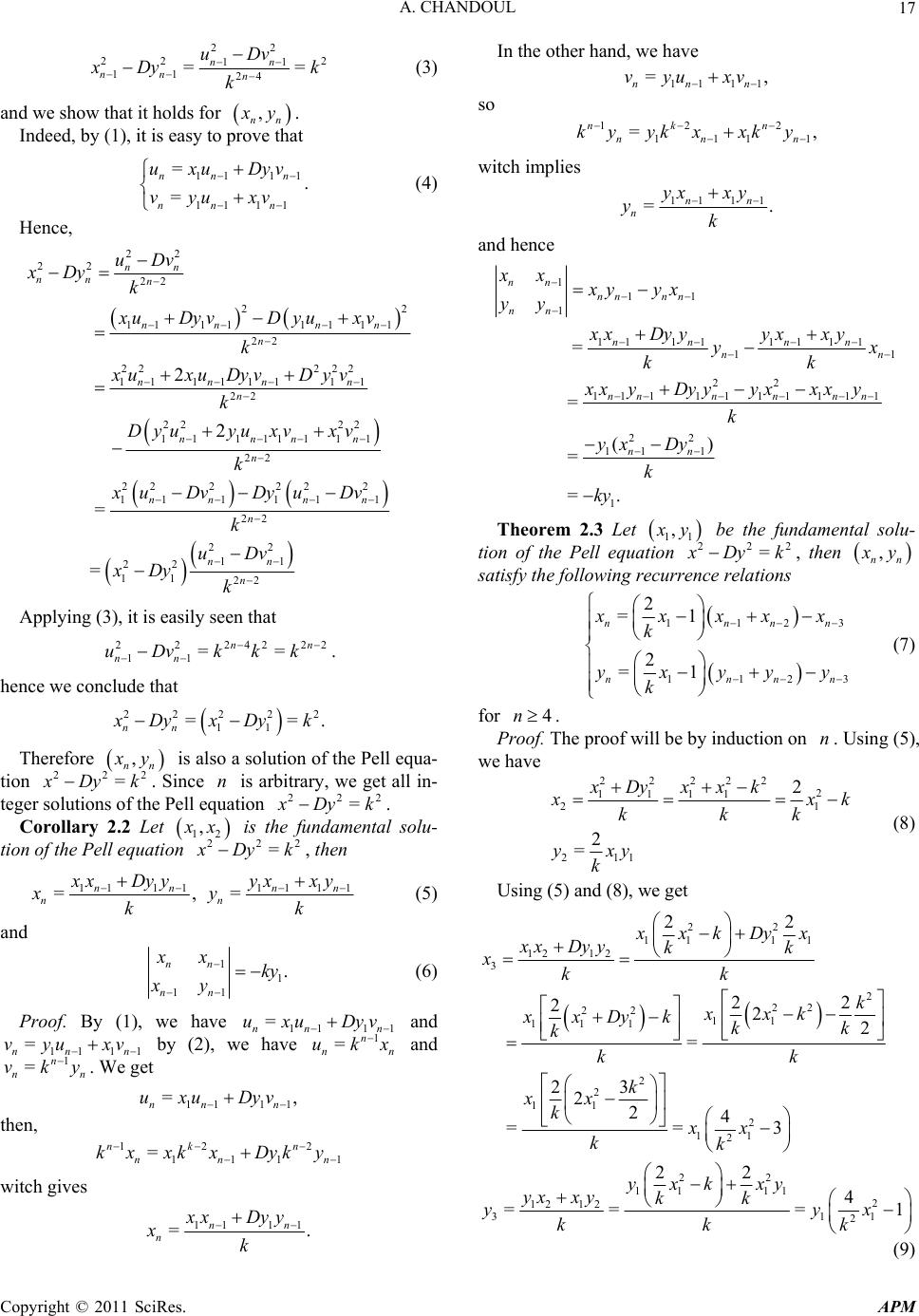 A. CHANDOUL Copyright © 2011 SciRes. APM 17 22 22 2 11 11 24 == nn nn n uDv Dy k k (3) and we show that it hold s for , nn y. Indeed, by (1), it is easy to prove that 11 11 11 11 =. = nn n nn n uxuDyv vyuxv (4) Hence, 22 22 22 22 111111 11 22 22 222 11 111111 22 22 22 11 111111 22 2 1 2 2 = nn nn n nn nn n nnn n n nnnn n n uDv xDy k xuDyvDyuxv k xuxu DyvDyv k Dyuyu xvxv k xu 22 222 11111 22 22 11 22 11 22 = nnn n nn n DvDy uDv k uDv xDy k Applying (3), it is easily seen that 2224222 11 == nn nn uDvkkk . hence we conclude that 22222 11 ==. nn Dyx Dyk Therefore , nn y is also a solution of the Pell equa- tion 222 = Dy k. Since n is arbitrary, we get all in- teger solutions of the Pell equation 222 = Dy k. Corollary 2.2 Let 12 , x is the fundamental solu- tion of the Pell equation 222 = Dy k, then 111111 11 =,= nn nn nn xDyy yxxy xy kk (5) and 11 11 . nn nn xx ky xy (6) Proof. By (1), we have 11 11 = nn n uxu Dyv and 11 11 = nn n vyu xv by (2), we have 1 =n nn ukx and 1 =n nn vky . We get 11 11 =, nn n uxu Dyv then, 12 2 1111 = nk n nn n kx xkxDyky witch gives 11 11 =. nn n xx Dyy xk In the other hand, we have 11 11 =, nn n vyuxv so 12 2 1111 =, nk n nnn ky ykxxky witch implies 11 11 =. nn n yx xy yk and hence 111 1 111111 11 11 22 1111111 111 22 11 1 1 = = () = =. nn nn nn nn nn nn nn nnn n nn nn xx xy yx yy xx Dyyyx xy yx kk xx yDyyyxxxy k yx Dy k ky Theorem 2.3 Let 11 , y be the fundamental solu- tion of the Pell equation 222 = Dy k, then , nn y satisfy the following recurrence relations 1123 1123 2 =1 2 =1 nnnn nnnn xxxxx k yxyyy k (7) for 4n. Proof. The proof will be by induction on n. Using (5), we have 22222 2 1111 21 211 2 2 = xDy xxk xk kkk yxy k (8) Using (5) and (8), we get 22 11 11 12 12 3 2 22 22 11 111 2 2 11 2 11 2 22 11 112 12 12 311 2 22 22 222 = 23 224 ==3 22 4 == =1 xxkDyx xx Dyykk xkk k xxk xxDyk kk k kk k xx kxx kk yxk xy yx xykk yyx kk k (9)  A. CHANDOUL Copyright © 2011 SciRes. APM 18 Then by (5) and (9), we fin d 4 and 4 y. 13 13 4 22 22 11 11 22 2222 2 11 11 22 42 11 3 13 13 4 22 11 111 1 22 2 11 1 3 44 31 44 3( )1 88 44 31 84 xx Dyy xk xx Dyx kk k xxxk x kk k xxk k k yx xy yk yx xxy x kk k xyx k k So, we obtained 42 411 3 2 411 1 3 88 84 xxk k k yxyxk k (10) Now, replacing (8) and (9) in (7), one obtains 41321 22 1111 1 2 32 11111 2 42 11 3 21( ) 242 13 24 2 13 88 . xxxxx k xx xkx kk k xxxxkx kk k xxk k k and 41321 2 111 111 2 2 111 3 21( ) 242 11 84 . yxyyy k yx xyy kk k xyx k k which are the same formulas as in (10). Therefore (7) holds for =4n. Now, we assume that (7) holds for 4n and we show that it holds for 1n. Indeed, by (5) and by hy p o t hesis we have 11 1 1112 3 1112 3 1111 1212 1 13 13 1 21( ) 21( ) 2 =1 2 =1 nn n nn n nn n nnnn nn xx Dyy xk xxxx x k k Dyxy yy k k xx DyyxxDyy x kk k xx Dyy k x k 12 . nn n xx x 11 1 1112 3 1112 3 11111212 1 13 13 1 = 21( ) = 21( ) 2 =1 2 =1 nn n nn n nn n nnn n nn yx xy yk yxxxx k k xxyy y k k yx xyyxxy x kk k yx xy k x k 12nn n yy y completing the proof. 3. The Negative Pell Equation 222 =xD k Theorem 3.1 Let 11 , y be the fundamental solution of the Pell equation 222 = Dy k , then the other so- lutions are 21 21 , nn xy , where 21 21 21 2122 ,= ,, nn nn nn uv xy kk (11) for 0n. Proof. We prove the theorem using the method of mathematical induction. For =0n, we have from (11), 111 1 ,=,uvxy which is the fundamental solution of 222 = Dy k . Now, we assume that the Pell equation 222 = Dy k is satisfied for 0n. So, 21 21 , nn xy , i.e. 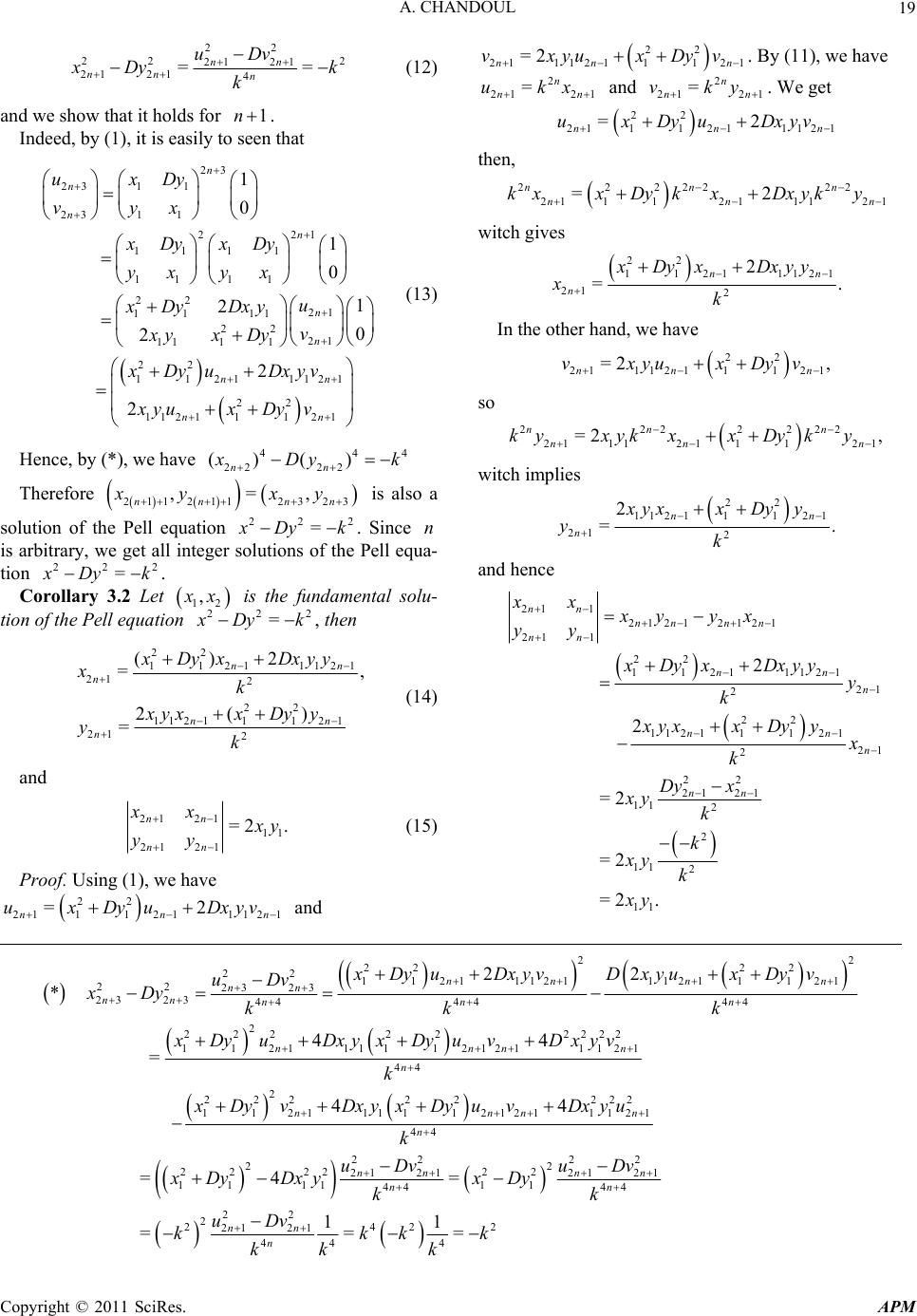 A. CHANDOUL Copyright © 2011 SciRes. APM 19 22 22 2 2121 21 214 == nn nn n uDv Dy k k (12) and we show that it hold s for 1n. Indeed, by (1), it is easily to seen that 23 23 11 23 11 221 1111 11 11 22 21 11 11 22 21 11 11 22 1121 11 1 0 1 0 1 2 0 2 2 n n n n n n n uxDy vyx xDy xDy yx yx u xDy Dxy v xyx Dy xDyu Dxyv 21 22 112111 21 2 n nn xyuxDy v (13) Hence, by ( *) , we ha ve 444 22 22 ()() nn Dy k Therefore 2323 211211 ,=, nn nn xy xy is also a solution of the Pell equation 222 = Dy k . Since n is arbitrary, we get all integer solutions of the Pell equa- tion 222 = Dy k . Corollary 3.2 Let 12 , x is the fundamental solu- tion of the Pell equation 222 = Dy k, then 22 11 211121 21 2 22 112111 21 21 2 ()2 =, 2() = nn n nn n xDyx Dxyy xk xyxxDy y yk (14) and 21 2111 21 21 =2 . nn nn xx y yy (15) Proof. Using (1), w e hav e 22 2111 211121 =2 nnn uxDyuDxyv and 22 21112111 21 =2 nn n vxyuxDyv . By (11), we have 2 21 21 =n nn ukx and 2 21 21 =n nn vky . We get 22 2111 211121 =2 nnn uxDyuDxyv then, 22222 22 21 11211121 =2 nnn nnn kxx DykxDxyky witch gives 22 11 211121 21 2 2 =. nn n xDyx Dxyy xk In the other hand, we have 22 21112111 21 =2 , nn n vxyuxDyv so 2222222 2111211121 =2 , nn n nn n kyxykxx Dyky witch implies 22 112111 21 21 2 2 =. nn n xyxxDy y yk and hence 2112121 2121 21 1 22 1121 1121 21 2 22 112111 21 21 2 22 2121 11 2 2 2 =2 nn nn nn nn nn n nn n nn xxxy yx yy xDyxDxyy y k xyxxDy yx k Dy x xy k 2 11 2 11 =2 =2. k xy k xy 22 22 22 22 1 121112111211 121 22 23 23 23 2344 4444 2 222 222222 1 121111 121211121 44 22 * 44 = nn nn nn nn nn n nnnn n xDyuDxyvDxyuxDyv uDv xDy kk k x Dy uDxyx DyuvDxyv k 2 222 22222 112111112121 1121 44 22 22 22 22 2222 21 2121 21 11 1111 44 44 22 2 22121 4 44 =4= = nnnn n nnnn nn nn n x DyvDxyx DyuvDxyu k uDv uDv xDyDxyxDy kk uDv kk 42 2 44 11 ==kkk kk 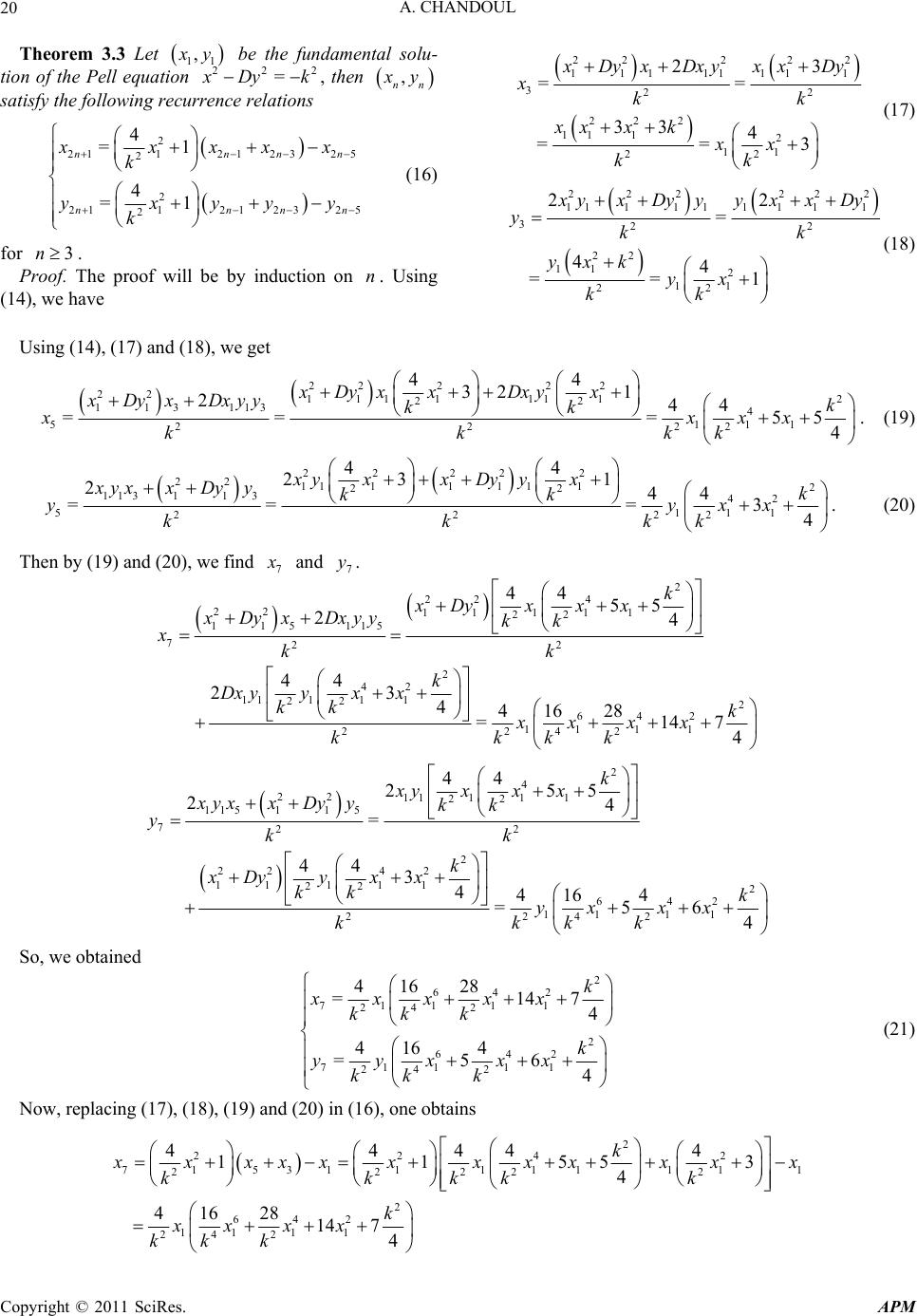 A. CHANDOUL Copyright © 2011 SciRes. APM 20 Theorem 3.3 Let 11 , y be the fundamental solu- tion of the Pell equation 222 = Dy k, then , nn y satisfy the following recurrence relations 2 211212325 2 2 21121 2325 2 4 =1 4 =1 nnnn nnnn xxxxx k yxyyy k (16) for 3n. Proof. The proof will be by induction on n. Using (14), we have 22222 11111111 322 222 11 12 11 22 23 == 33 4 ==3 DyxDx yxxDy xkk xxx kxx kk (17) 222222 111 11111 1 322 22 11 2 11 22 22 = 44 ==1 yxDyyyxxDy ykk yxk yx kk (18) Using (14), (17) and (18), we get 2222 2 22 111111 12 22 113 1134 5111 2222 44 32 1 244 == =55 4 xDyx xDxyx xDyx Dxyyk kk xxxx kkkk . (19) 22 222 22 11 1111 12 22 11311 342 5111 2222 44 23 1 244 == =3 4 xyxxDy yx xyxxDyyk kk yyxx kkkk . (20) Then by (19) and (20), we find 7 and 7 y. 2 22 4 22 11111 22 115 115 722 2 42 1111 1 22 2 642 111 1 2242 4455 24 44 23 4416 28 =1474 k xDyxx x xDyx Dxyykk xkk k Dx yyxx kk k xx xx kkkk 2 4 22 11111 22 11511 5 722 2 22 42 11 111 22 2 642 11 11 2242 44 255 24 = 4434416 4 =564 k xyxxx xyxxDy ykk ykk k xDyyxx kk k yx xx kkkk So, we obtained 2 642 71111 24 2 2 642 711 11 24 2 416 28 =147 4 416 4 =56 4 k xxxxx kk k k yyxxx kk k (21) Now, replacing (17), (18), (19) and (20) in (16), one obtains 2 2242 71531111111 1 22222 2 642 11 11 24 2 44444 11553 4 416 28 1474 k xxxx xxxxxxx kkkkk k xx xx kk k 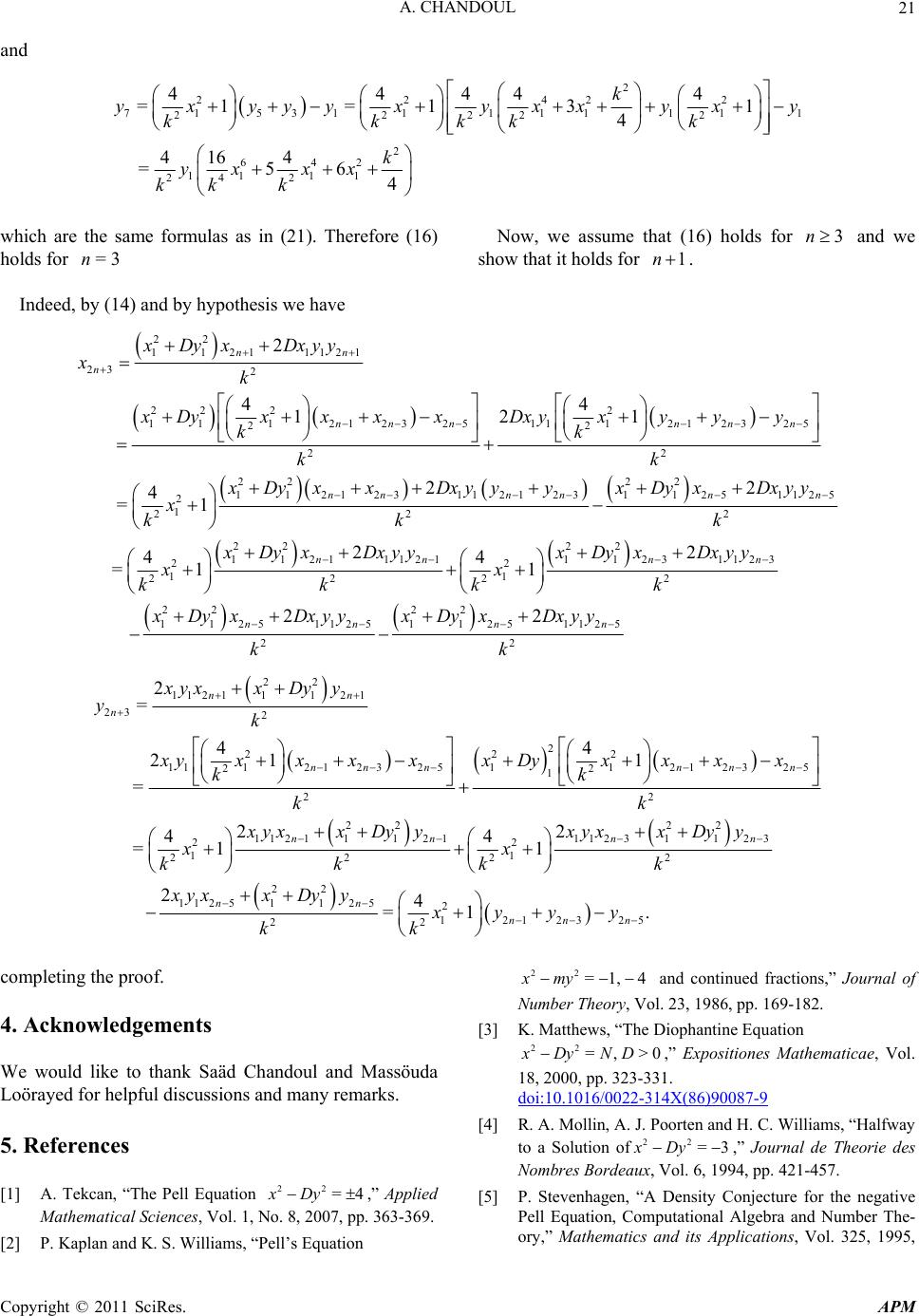 A. CHANDOUL Copyright © 2011 SciRes. APM 21 and 2 22422 71531111111 1 22222 2 642 11 11 24 2 44444 =1 =131 4 416 4 =564 k yxyyyxyxxyx y kkkkk k yx xx kk k which are the same formulas as in (21). Therefore (16) holds for =3n Now, we assume that (16) holds for 3n and we show that it holds for 1n . Indeed, by (14) and by hypothesis we have 22 11 211121 23 2 22 22 11121 2325111212325 22 22 22 2 11212311 21231 2 1 22 2 44 121 2 4 =1 nn n nn nnnn nn nn xDyx Dxyy xk xDyxx xxDxyxy yy kk kk xDyxxDxyyyx x kk 2 125 1125 2 22 22 1 12111211 1231123 22 11 2222 22 22 11 25112511 251125 22 2 22 44 =11 22 nn nn nn nn nn DyxDx y y k x DyxDxyyx DyxDxyy xx kkkk xDyx DxyyxDyx Dxyy kk 22 112111 21 23 2 2 222 111212325112123 25 22 1 22 22 112111 2111 22 11 222 2 = 44 21 1 = 22 44 =11 nn n nn nnn n nn xyxxDy y yk xyxx xxxDyxx xx kk kk xyxxDy yxy xx kkk 22 2311 23 2 22 112511 252 1212325 22 24 =1. nn nn nnn xxDyy k xyxxDy yxyyy kk completing the proof. 4. Acknowledgements We would like to thank Saäd Chandoul and Massöuda Loörayed for helpful discussions and many remarks. 5. References [1] A. Tekcan, “The Pell Equation 22 =4xDy,” Applied Mathematical Sciences, Vol. 1, No. 8, 2007, pp. 363-369. [2] P. Kaplan and K. S. Williams, “Pell’s Equation 22 =1, 4xmy and continued fractions,” Journal of Number Theory, Vol. 23, 1986, pp. 169-182. [3] K. Matthews, “The Diophantine Equation 22 =,>0xDyND,” Expositiones Mathematicae, Vol. 18, 2000, pp. 323-331. doi:10.1016/0022-314X(86)90087-9 [4] R. A. Mollin, A. J. Poorten and H. C. Willia ms, “Halfway to a Solution of22 =3xDy ,” Journal de Theorie des Nombres Bordeaux, Vol. 6, 1994, pp. 421-457. [5] P. Stevenhagen, “A Density Conjecture for the negative Pell Equation, Computational Algebra and Number The- ory,” Mathematics and its Applications, Vol. 325, 1995, 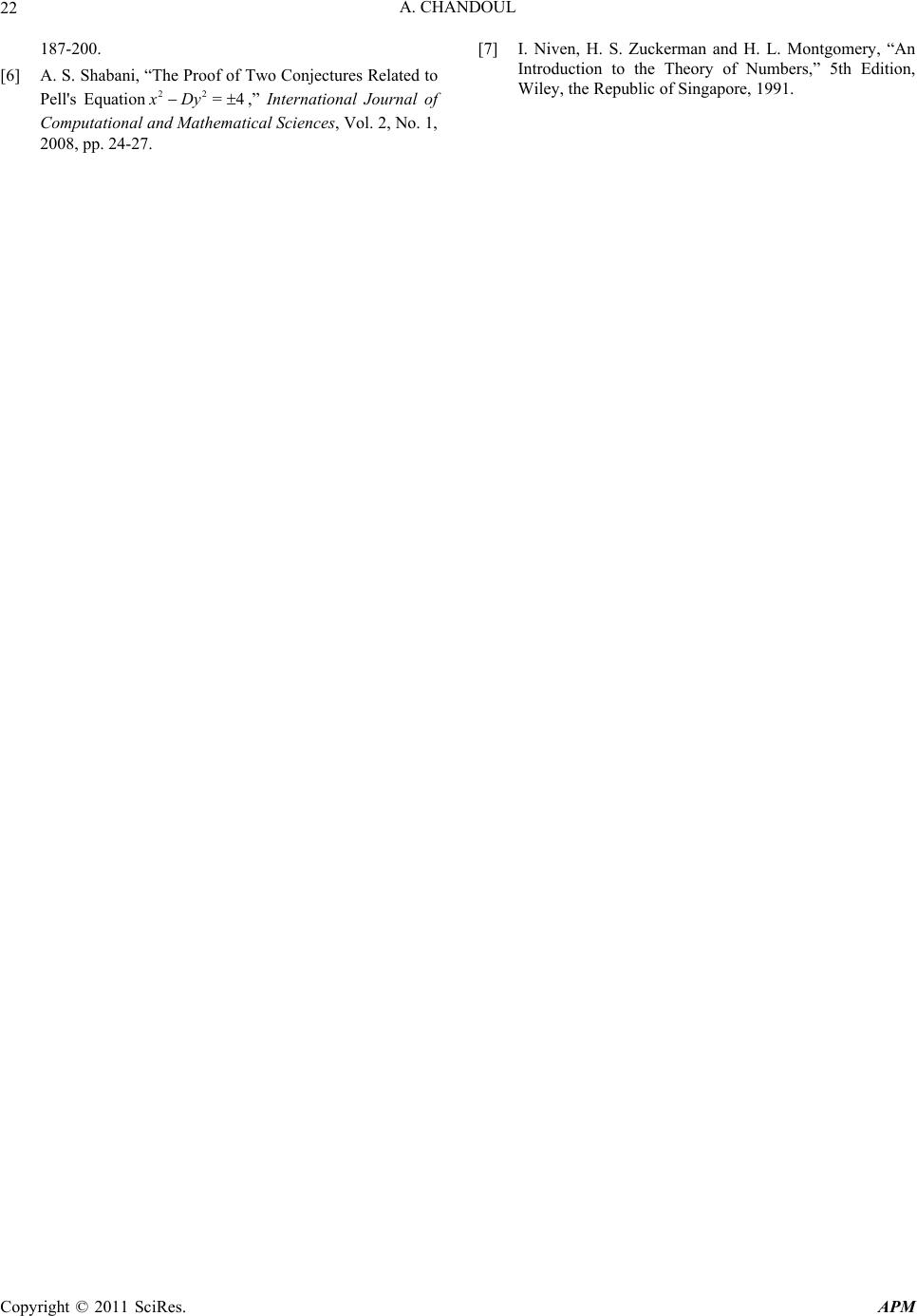 A. CHANDOUL Copyright © 2011 SciRes. APM 22 187-200. [6] A. S. Shabani, “The Proof of Two Conjectures Related to Pell's Equation22 =4xDy,” International Journal of Computational and Mathematical Sciences, Vol. 2, No. 1, 2008, pp. 24-27. [7] I. Niven, H. S. Zuckerman and H. L. Montgomery, “An Introduction to the Theory of Numbers,” 5th Edition, Wiley, the Republic of Singapore, 1991.
|